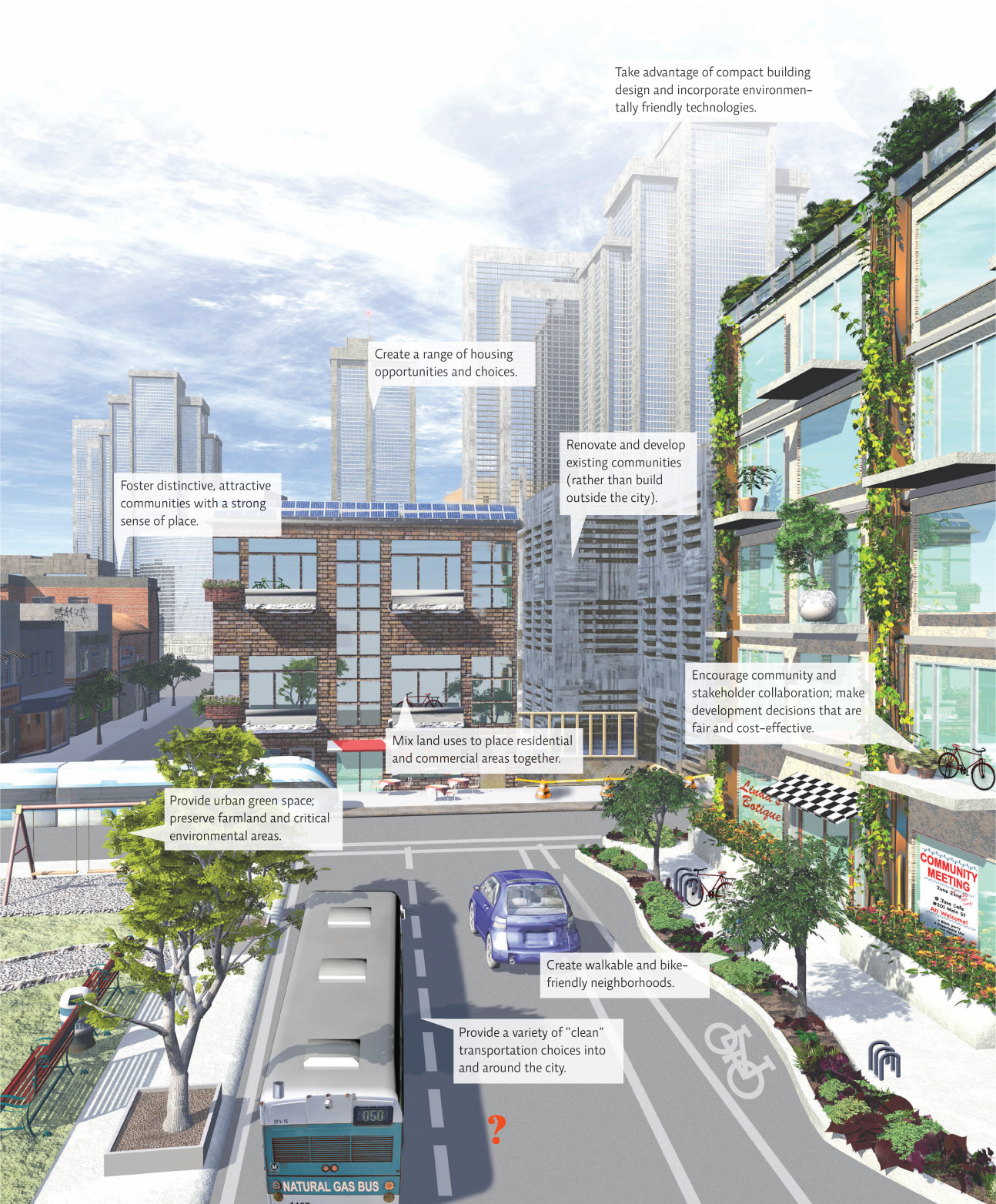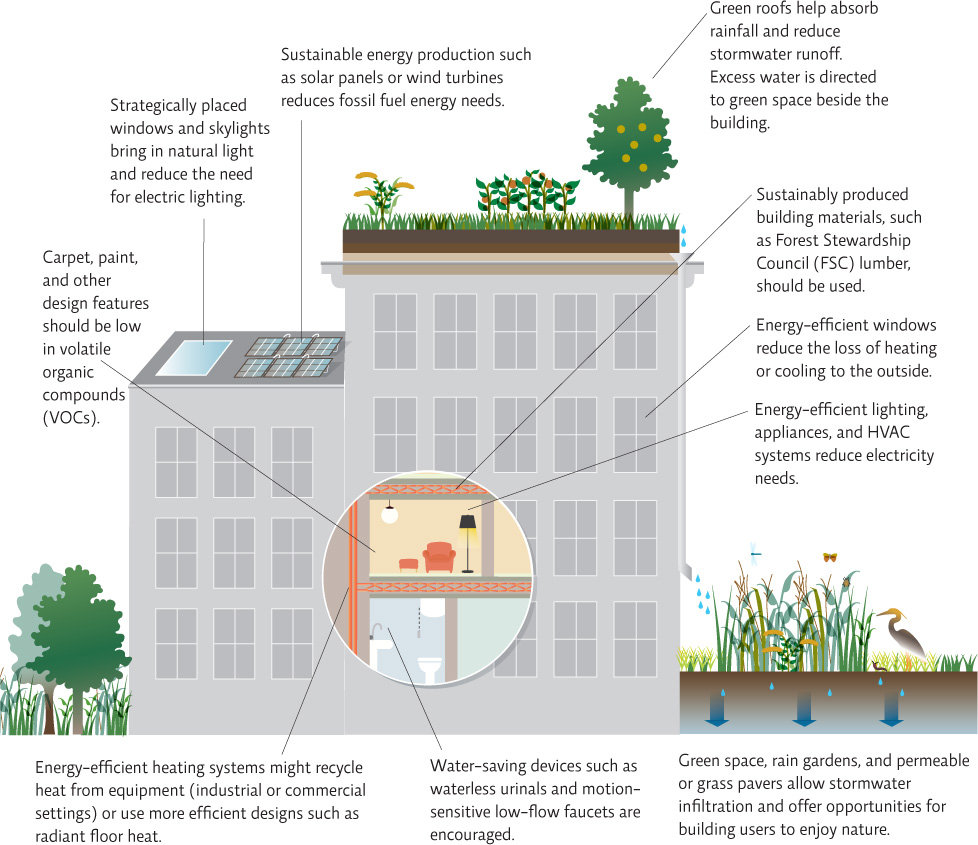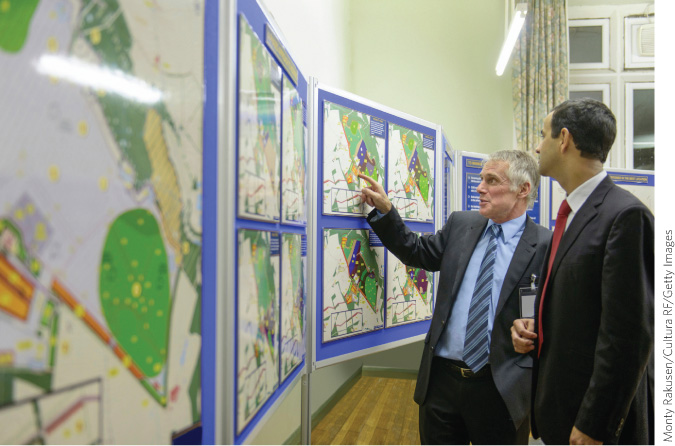The future depends on making large cities sustainable.
Sustainable cities are cities where the environmental pros outweigh the cons—where sprawl is minimized, walkability is maximized, and the needs of inhabitants are met locally. In recent years, urban planners have come up with a wide range of strategies for accomplishing these goals. To achieve self-sufficiency, for example, a sustainable city might maintain a mixture of open and agricultural land along its outskirts. Such land could provide a large part of the local food, fiber, and fuel crops, along with recreational opportunities and ecological services. Waste and recycling facilities could also be located nearby, along with other enterprises aimed at producing resources needed by area residents. To stave off sprawl, the same city might establish urban growth boundaries—outer city limits beyond which major development would be prohibited. Keeping any outward growth that does occur as close to mass transit as possible minimizes the impacts of transportation, just as building “up” (a parking garage) rather than “out” (an expansive parking lot) minimizes the amount of land used. To encourage more walking and less driving, zoning laws might allow for mixed land uses, where residential areas are located reasonably close to commercial and light industrial ones.
KEY CONCEPT 25.6
The quest for sustainability must include cities. Smart growth allows cities to develop in a way that minimizes environmental impact while enhancing community living.
Of course, building an ideal city from scratch is easy compared with the task of overhauling an existing city, especially when that city is as densely populated and ever expanding as New York. Upgrading decaying infrastructure like roads, public places, and sewage and water lines can be more expensive than new construction, and the process is disruptive to residents. Urban retrofits are certainly possible, but sometimes their very success raises property values to the point that the original residents can no longer afford to live in their own neighborhoods. Even so, there are plenty of ways that American cities can push themselves into the environmental plus column. For example, infill development—the development of empty lots within a city—can significantly reduce suburban sprawl. And even the most car-friendly of cities has a range of options for reducing traffic congestion and the air pollution that comes with it: reliable public transportation, car-sharing programs that allow residents to use cars when needed for a monthly fee, and sidewalks and overhead passageways that allow pedestrians to safely cross busy roads. The cumulative effect of strategies like these, which help create walkable communities with lower ecological footprints, is known as smart growth. INFOGRAPHIC 25.6
infill development
The development of empty lots within a city.
smart growth
Strategies that help create walkable communities with lower ecological footprints.
Smart growth can be applied to large cities or to smaller communities. It employs strategies that make efficient use of land to create pleasant livable communities with a lower ecological footprint than current suburban areas.


Which of these smart growth principles would be most appealing to you if you were looking for a place to live in a city?
Answers will vary but should be supported.
Persuading people to support smart growth, as Carter and her colleagues soon discovered, is a matter of showing them that the benefits could be economic as well as environmental. “You need to show them what we call the triple bottom line,” says James Chase, vice president of SSBx (and Carter’s husband), referring to the economic, social, and environmental impacts of any decision. “Developers, government, and residents all need some tangible, positive return.” A major park project would surely be a boon for all three. Developers would be guaranteed millions in waterfront development contracts. Residents could look forward to cleaner air and water, a prettier neighborhood, and better health as a result. The state and city governments would save a bundle in health care costs. The greenbelt would also spur the local economy: Such a vast stretch of public space would attract street vendors, food stands, bicycle shops, and sporting goods stores.
KEY CONCEPT 25.7
Green building design focuses on efficient use of energy, and water, and on building materials with low environmental and health impacts.
Smart growth also requires a green workforce. Some of the undeveloped property that Carter and her neighbors hoped to convert into parkland was contaminated with hazardous waste. These sites are called brownfields, and they require a special type of clean-up, or remediation, before they can be developed.
The surrounding wetlands, suffering from decades of neglect, would also need to be restored. And maintaining the new trees, plants, and parks SSBx hoped to create would require a workforce trained in urban forestry. Anxious to claim these emerging professions—all of which promised job security and living wages—for their own community, Carter and her neighbors launched the Bronx Environmental Stewardship Training—a green job training program that teaches South Bronx residents the principles of urban forestry, brownfield remediation, and wetland restoration. Program participants—many of them ex-convicts and high school dropouts facing prison time—also learn how to install solar panels and retrofit older buildings to make them energy efficient. So far, 82% of the participants have found jobs in the green economy, and 15% have gone on to college. “Once we figured out the employment factor, we had a win—win— win,” says Chase. “There’s all these jobs—good jobs— that are going to take off in the next decade, but that not a lot of people know how to do right now. It was a clear opportunity for us.”
The green economy includes a movement known as green building—that is, the construction of buildings that are better for the environment and the health of those who use them. Buildings that meet a minimum standard are awarded a Leadership in Energy and Environmental Design (LEED) certification by the U.S. Green Building Council. Points are awarded based the council’s evaluation of how well the building meets certain criteria, such as energy and water efficiency, the use of sustainable resources, and indoor environmental quality. The Bronx Library Center is a silver-certified LEED building. It earned the silver certification by recycling 90% of the waste materials created during the construction of the building, using architectural design and efficient heating and cooling systems to save 20% of energy costs, and using sustainably grown wood in 80% of the construction lumber.
green building
Construction and operational designs that promote resource and energy efficiency and provide a better environment for occupants.
LEED (Leadership in Energy and Environmental Design)
A certification program that awards a rating (standard, silver, gold, or platinum) to buildings that include environmentally sound design features.
Carter and her team also launched Smart Roofs, LLC, a green-roof and green-wall installation company. Green roofs are one type of rain garden—an area seeded with plants suited to local temperature and rainfall conditions. (See Chapter 15 for more on rain gardens.) A 2004 study by the New York City Department of Design and Construction found that consumers could save more than $5 million in annual cooling costs if green roofs were installed on just 5% of the city’s buildings. According to a study by Columbia University, the same amount of green roofing could achieve an annual reduction of 350,000 metric tons of greenhouse gases. And Riverkeep, an environmental nonprofit, found that green roofs can retain 3,000 liters of storm water for every $1,000 of investment—easing pressure on the city’s overburdened sewer systems and mitigating water pollution from storm runoff. Green roofs also lessen the urban heat island effect. INFOGRAPHIC 25.7
Many steps can be taken to build or retrofit a building so that it has less environmental impact and is a healthier environment for those who live, work, or go to school there. The nonprofit group Green Building Council certifies buildings through its LEED program (Leadership in Energy and Environmental Design). A building receives a standard, silver, gold, or platinum rating, based on a variety of criteria that include energy efficiency, sustainable building material use, and innovative design.


How could a LEED-certified building help address urban problems such as the urban heat island effect and stormwater issues?
More energy efficient buildings generate less waste heat so they contribute less to the heat island effect. Green roofs could also lessen this effect. In cities it is important to reduce stormwater runoff since so much of the ground in made of impervious substances that don’t allow the water to soak in to the ground. Green roofs and rain gardens decrease the building’s contribution to stormwater by giving the water a place to go rather than into storm drains.
To help the company take off, SSBx secured tax credits from the state legislature. Building owners who install green roofs on at least 50% of their available rooftop now receive a 1-year property tax credit of up to $100,000. Carter offered up her own roof as the first test case.
By the time the Hunts Point Riverside Park opened, dozens of cities across the country—from Madison, Wisconsin, to Miami, Florida—had taken up the mantle of sustainability and smart growth. In 2013 the United States led the world in green building, with more than 44,000 LEED-certified buildings or projects under construction. That same year, the EPA gave out five National Awards for Smart Growth Achievement. The Bronx received an honorable mention award for Via Verde, a LEED Gold mixed-income housing complex built on a former rail yard that incorporates a wide variety of green building features such as solar panels, natural lighting, and green roofs. It also has easy access to transportation and a neighborhood medical clinic on site. The project was so successful, it prompted New York City to change its green zoning rules to make it easier to implement similar projects throughout the city.
Select References:
Beckett, K., & A. Godoy. (2010). A tale of two cities: A comparative analysis of quality of life initiatives in New York and Bogotá. Urban Studies, 47(2): 277–301.
Carter, M. (2006). “Greening the Ghetto,” www.ted.com/talks/majora_carter_s_tale_of_urban_renewal.
Dodman, D. (2009). Blaming cities for climate change? An analysis of urban greenhouse gas emissions inventories. Environment and Urbanization, 21(1): 185–201.
Ewing, R., et al. (2003). Relationship between urban sprawl and physical activity, obesity, and morbidity. American Journal of Health Promotion, 18(1): 47–57.
Heilig, G. K. (2012). World Urbanization Prospects: The 2011 Revision. New York: United Nations, Department of Economic and Social Affairs (DESA), Population Division, Population Estimates and Projections Section.
PERSONAL CHOICES THAT HELP
A sustainable community is one that promotes economic and environmental health and social equity. It is one in which the health and well-being of all citizens are considered, while those citizens help implement and maintain the community.
Individual Steps
•Investigate and support sustainable businesses in your area (see www.sustainablebusiness.com). Research products before you purchase them to understand the impact of your consumption choices (see www.goodguide.com).
•If you have a balcony or yard, plant flowers, vegetables, or trees.
•Support local businesses by shopping and dining close to home.
Group Action
•Join neighborhood clean-up days. If you can’t find one, organize one.
•Reduce reliance on cars. Start a petition to get more bike lanes in your city. Ride public transit more often.
•Find out how colleges and universities are working toward sustainable practices at www.AASHE.org.
Policy Change
•Attend a meeting of your city council or county commission and ask members to look into smart growth opportunities.
•See how well you can plan for a sustainable community. Play the PC strategy game Fate of the World (www.fateoftheworld.net) and see how policies you put in place impact global climate change, rain forest preservation, and resource use.
